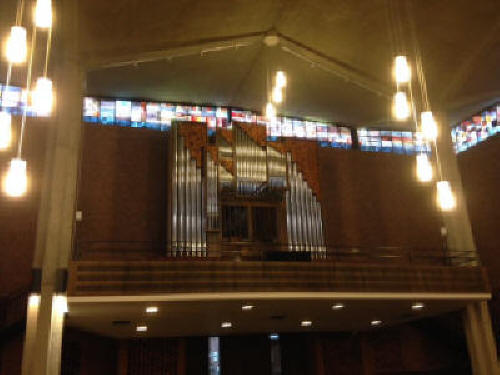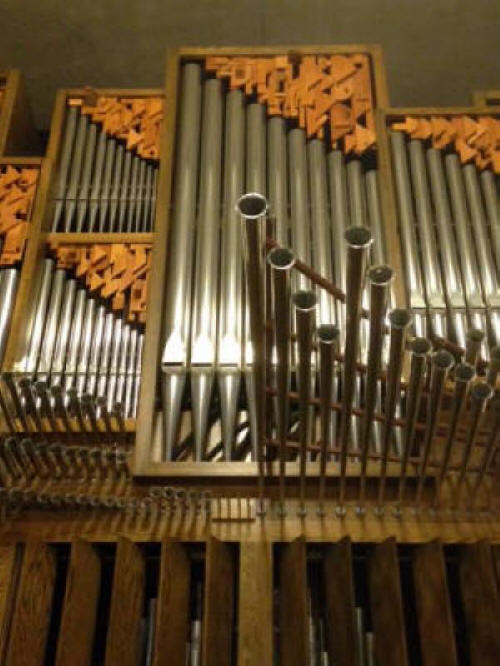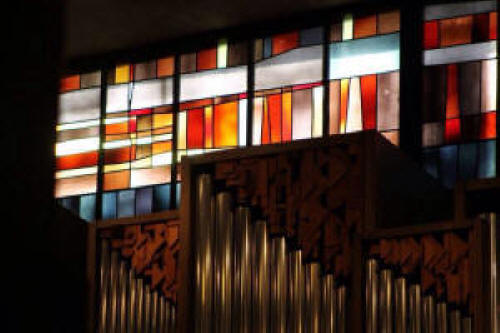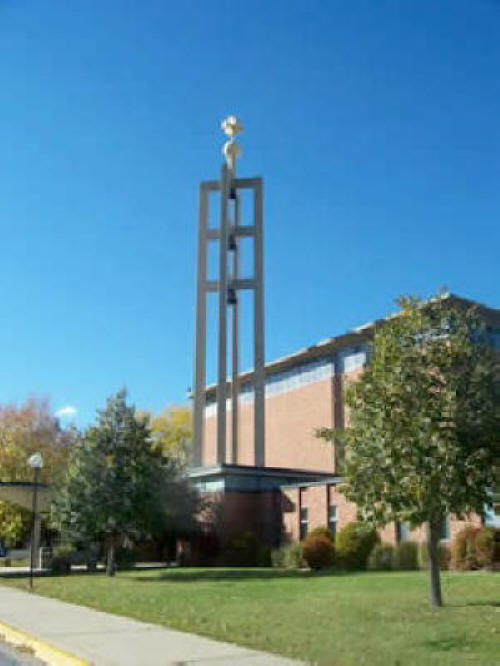|
Builder: Hendrickson Organ Co, Opus 45 (1978) Manuals: 2 Ranks: 44 Stops: 29 Action: Mechanical, electric stop action Notes: from Charles Hendrickson: Yes, the opus 2 at Fist Lutheran in St. Peter was a little 2 manual 8-rank rental organ ($50 per month) which I quickly installed and had operating before the new building was finished. It was very successful and was there for 13 years until we sold it to a church in Spirit Lake, Iowa (where it still remains as opus 56 of 1979). It was replaced at First Lutheran with our permanent, opus 45 tracker of 2 manuals, 43 ranks in 1978. It is now 44 ranks. --Information and photos from Hendrickson Organ Co. and Facebook -- Manual I is a coupler keyboard Last Update: 7/2012 HAUPTWERK 10 stops, 14 ranks 65 mm wind pressure, exposed Keyboard II, 812 pipes 8 Prestant 8 Rohrflöte 8 Dolce 4 Octave 4 Spitzflöte 2 Waldflöte 1 1/3 Mixture IV 2 2/3 Sesquialter II 8 Trumpet 8 Horizontal Trumpet Tremulant SWELL ORGAN 11 stops, 14 ranks 50 mm wind pressure, enclosed Keyboard III, 795 pipes 8 Gedackt 8 Spitzgamba bf cb 8 Schwebung tc 4 Principal 4 Spitzflöte 2 Octave 1 1/3 Quint 2/3 Mixture IV 16 Dulzian 8 Oboe 4 Clarion (2012) TremulantPEDAL ORGAN 9 stops, 16 ranks 75 mm wind pressure, 412 pipes 32 Harmonics VI-I 16 Prestant (ext 8' Octave) 16 Subbass 8 Octave 8 Spitzflöte 4 Octave 2 2/3 Mixture IV 16 Posaune 4 Schalmey Tremulanthttp://www.flcstp.org/ Pipe shades and overall asymetrical case profile inspired by the Aldern brick sculpture on the front wall behind the altar. The wall tells the story of Creation, starting behind the altar and progressing up the wall to retell the story. At the bottom, out of the void, come basic shapes of matter, and water and clouds. Half way up on the left we see sun, moon and stars, with fish and growing things on the right. Next come cattle and birds. The human family, with Christ at its center, is at the top, with more stylized birds at the right in the basic shape used in the pipe shades. The sculpture (part of which is shown here) by Robert Aldern can be seen in its entirety in the following document on page 18: http://www.aldernartstudios.com/_assets/pdf/aldern_retrospective_1997.pdf The building itself, made of brick and concrete, was designed by Sioux Falls architect Harold Spitznagel of Spitznagel and Associates: http://teamtsp.com/haroldspitznagel/ In some ways, these unburnable materials were a response to the fire that burned the original church following a lightning strike on May 13, 1962, Mother's Day. The church bell, which fell from the burning tower and sustained a crack in its mounting, serves as a memorial outside the new church near the front door. The first service was held on September 5, 1965. Locally known as the "God Box", the building is 76' on each side and 40' tall -- roughly half a cube. These hard surfaces provide an exceptional acoustic which benefits the choir and the organ. In August when the air is humid and heavy, reverberation is around 4-5 seconds, less in the winter. Reverberation is not significantly affected by presence of a congregation. The tower bells were added later. They are "Te Deum" bells, based on the first three notes of the Te Deum hymn as heard in the tower bells at a Lutheran church in Bad Oeynhausen, Germany. They play the pitches G/B-flat/C, which work with the old bell playing E-flat on the rare occasions when the old bell might be rung manually. Happily, the enharmonic spelling G-A#-C happens to be the common abbreviation for Gustavus Adolphus College, located just a mile south of the church. As far as we knew at the time of installation, this is the only place in the United States with these particular intervals. -- Information from "Three Sundays at First" by Don Gustafson, August, 2007, and David Engen, organist from early 1970's to mid 1980's. |
 |
 |
|
 |
|
 |
|
 |
|
|
|
|